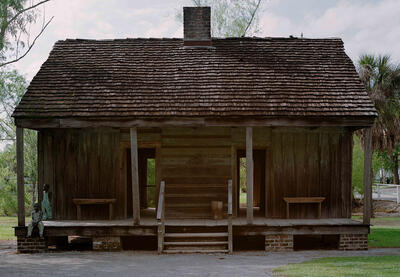Sugar cane dominates the view along Highway 18 in Louisiana’s River Parishes. The fields’ bounty, over 10 feet tall during the fall harvest season, stretches as far as the eye can see between small rural towns, churches and industry. These fields along the Mississippi River are the remnants of the hundreds of thousands of cash crop acres cultivated on plantations that, between 1719 and 1865, generated millions of dollars of wealth for enslavers, European colonial powers and the United States. Dotting the landscape are some former plantations, now transformed into historic house museums and sites, highlighting the beautiful architecture, manicured grounds and grandeur of collective stereotypes about the Old South.
But a parallel story to those sites exists, one that challenges the mythology of the Old South—a
story rooted in survival, resistance and resilience.
The Power of Place
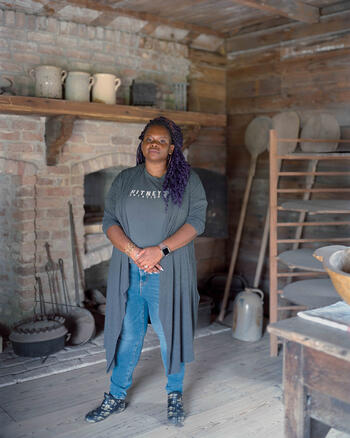
Located between New Orleans and Baton Rouge, Louisiana, in the descendant communities of Wallace and Edgard, Whitney Plantation is an 18th-century sugar plantation turned historic site dedicated to sharing the history of slavery in the U.S. from the perspective of the people who were enslaved. Unlike many other former plantations whose tours and narratives focus on the lives of the “great” wealth-accumulating white family dynasties who lived in their beautiful big houses, Whitney Plantation elevates the stories of those whose forced labor made that wealth possible: enslaved Africans, African Americans and, in Southeast Louisiana, Creoles of color. Whitney offers a vision of the Old South in opposition to traditional plantation tour narratives that lessen or ignore the experiences of enslaved Black people and their descendants while uplifting white supremacist ideas about the U.S. and the people who built wealth in the Atlantic World.
At the heart of Whitney Plantation is a representation of the life and labor of Africans in the U.S. who built so much of what we hold dear today. Plantation life played out in a complex, unique pattern that people throughout this country are still working through today.
The current 250-acre plantation site is a collection of three elements: original buildings like the big house, detached kitchen and French Creole barn, all built around 1790; buildings brought from other Louisiana sites for preservation and education; and memorials to those who lived through chattel slavery, both on this land and in the larger United States. In each of these locations, our goal is to re-center the stories of those who survived the institution of slavery through tenacity, strength and ingenuity.
In the big house, women who worked as domestics—whose proximity to their enslavers posed different dangers than those faced by their counterparts in the fields—used their positions to gain information that they shared with other enslaved people, or to take small moments to exercise their humanity. Places like kitchens, blacksmith shops and sugar-boiling houses were run by highly skilled individuals who crafted items into patterns and recipes still found today all over Louisiana and the country. And while field hands in the sugar cane fields worked to the brink of exhaustion, they still claimed their individual freedoms through truancy and self-emancipation and by using their smarts to navigate a system built to keep them in chains. By reconceptualizing the stories of slavery as stories of capitalism built on human trafficking, we’ve opened new paths for questioning how history is studied, taught and celebrated. Honoring the lives and experiences of enslaved people has resonated with the nearly 500,000 visitors who have joined us looking to better understand slavery in the U.S., the people who survived it and their legacies as individuals—and what these plantation histories can tell us about our society today.

Connecting With History and Questioning Narratives
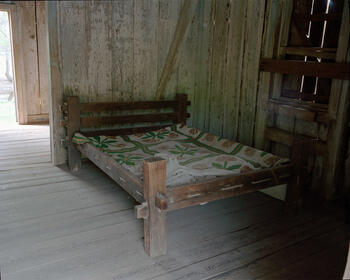
For young people, the education team at Whitney Plantation has curated a tour that encourages them to think, listen, talk and connect with the history, the site and one another through inquiry-based and experiential learning. Field trips are essential to holistic learning experiences, especially when learning about people and events ignored in or deliberately erased from historical narratives. For sites of slavery like Whitney Plantation, physical spaces allow for empathy and connection to the past, where books and other two-dimensional sources fall short. At Whitney Plantation, our team aims to help all learners recognize their power to be critical thinkers and connection-builders through uplifting stories of Black resilience, resistance and strength in the face of unparalleled tragedy. It is important to remind our visitors that Black people were and are at the center of the story of the U.S. and that we have the right to question past and present narratives.
We start our educational tour with seemingly simple questions: “What is slavery? What is a plantation?” The answers always vary—“a farm,” “a violent place,” “a place where they kept Black people,” “a slave-labor camp”—and none of them are wrong. We encourage students to look around where they are: in a place where, between 1752 and 1865, over 350 people had their human rights and their dignity, freedom and labor stolen from them. These people’s physical, emotional, mental and reproductive labor fueled the triangular trade in the New World throughout the earliest years of what would become the United States. Their work funded the growth of our modern world on both sides of the Atlantic.
“Black cultural practices and performances born in these places have pushed beyond the Southern United States to become a worldwide force today—and the perfect example of resistance in action.”
Using the buildings and grounds as our classroom, we move through 175 years of bondage for people of African descent in Louisiana. We discuss how, despite the intense cruelty of their situation, people not only existed in this world but created their own. Their lived experiences were as complex as our own: Every moment of joy, anger, despair, love and humor that we have ourselves, they had also. While the conditions of slavery in the U.S. were brutal and crushing for the millions of men, women and children who by law were not considered fully human, people found ways to resist, rebel and survive enslavement in a place they were never meant to be.
Resistance in Action
The tour truly comes to life in the quarters, where individuals who labored in the sugar fields—one of the most dangerous places to work—rested and were allowed to exist as Black people. At most plantations, the quarters were where families lived, friendships grew and love blossomed. In these homes, despite meager conditions, cultures of the Mandinka, the Wolof, the Fulani and countless other Central and West African ethnicities mixed with Indigenous and European elements to create something entirely new: African American identity. Black cultural practices and performances born in these places have pushed beyond the Southern United States to become a worldwide force today—and the perfect example of resistance in action.
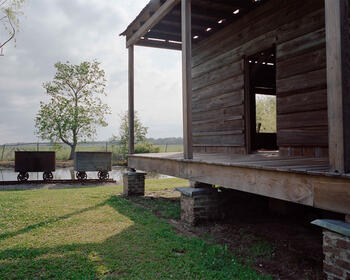
When confronted with these realities during their visit, learners of all ages realize we aren’t merely in some place to look passively at history—we are in an active, transformative space where our understanding of the lives of people who were enslaved is challenged directly. This history lives and breathes every day, and we have a role in changing the narratives around enslavement and Black people in the U.S.
A certain power comes with being in a space where seemingly distant events happened—a magic moment, unique to each person, where one becomes physically connected to the past. I see it every day: when a teen spends time in a dwelling where enslaved people lived, thinking about that building’s location in physical space and time, about who might have lived there and what their lives were like, feeling the heat of a Louisiana summer. When they move out of that space and see the harvesting of sugar cane, talk with a classmate about how a person resisted becoming property and see evidence of that resistance in today’s descendant communities. When visitors come to Whitney Plantation, they start as newcomers looking for understanding. By the end, they are witnesses to the legacies of this underexplored history and have a better knowledge of how we all can uplift those who have been silenced by white supremacist historical practices.
After spending time at Whitney, most people are energized to share what they’ve learned but may not be sure where to go from here. Slavery in the U.S. is a thread that touches nearly every topic relevant to our society today. Of course, subjects like the Black Lives Matter movement, mass incarceration and the overpolicing of Black and Brown people are direct connections. However, Whitney Plantation’s location on the Gulf Coast also allows us to talk about collective issues such as climate change and its effects on historic sites, as well as environmental racism and Black rural communities (our location is in the center of Louisiana’s “Cancer Alley”). Again, using our site as a jumping-off point, we launch into the challenges facing our communities today and become better informed about how history affects the issues most critical to us right now: justice, civic engagement and our collective future. Our goal is to shape our visitors into critical thinkers who can make connections between past and present and communicate in ways that enhance our future.
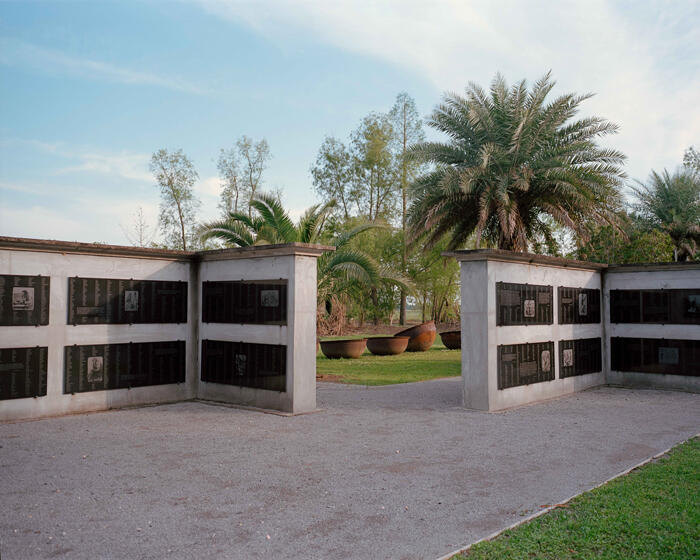
As I walk on-site every day, I pause to reflect on this unique opportunity to speak on the stories of our ancestors. Having worked in museum education for many years, I take pride in helping people understand complex historical topics and experience cultural institutions through a unique lens. But as a Black woman who is a descendant of enslaved people from Georgia and the Carolinas, I am honored and moved by this opportunity to have a direct hand in developing an interpretation that places us in the center rather than at the margins of our own experiences. To walk in places where they lived and loved despite the challenges surrounding them; to say their names and return the power denied to them in life and death—these actions make my role in shaping the interpretation of Whitney Plantation deeply meaningful. “Education leads to liberation,” as our staff says, and we get to model that through our interpretation daily.
Between 1752 and 1860, over 350 Africans, African Americans and Creoles of color were enslaved at Habitation Haydel—now Whitney Plantation.
Research is an ongoing project for the museum, and we have uncovered the stories of several individuals through inventories, sales receipts, baptismal records and local family histories.
Anna and Victor
Anna was enslaved as a domestic at Habitation Haydel, brought to the site during the internal U.S. slave trade (1820-1860). As a domestic, Anna lived and worked in the big house, with direct contact with the enslaver Haydel family—a dangerous place for a young woman seen as property and not as a person. Around age 25, Anna was sexually assaulted by Antoine Haydel, the brother of the site’s owner, resulting in the birth of her son, Victor, in August 1835. Victor Haydel lived and worked at Habitation Haydel well after the end of the Civil War. Sybil Haydel Morial, Victor’s great-granddaughter, is an educator, activist and community leader in New Orleans and the city’s first Black first lady. She is also the mother of the third Black mayor of New Orleans and the current National Urban League president, Marc Morial.
Lise and Hilaire
Lise is first found in the baptismal records of St. John Parish Catholic Church in 1799. Though her mother’s name was lost in damage to the record, Lise’s mother was likely from West or Central Africa or a first-generation African American. Lise lived on Habitation Haydel starting around 1820, where she married Hilaire, a “good cart driver, herdsman, and plough hand.” They are listed by their enslavers as valued between 1,600 and 100 “piastres” in records that span until 1860. However, their value to their community was much higher: Lise is listed in baptismal records as godmother to many children born at the plantation between 1825 and 1860. Both she and her husband are also found in the 1870 census records at 70 and 65 years old, still living on the plantation among the newly freed community. We can infer that Lise and Hilaire were essential members of the Black community of Habitation Haydel before, during and after emancipation.
Julienne and Marie
Julienne and Marie were cooks at Habitation Haydel between 1840 and 1860. The kitchen was one of the most powerful places on a plantation: Cooks controlled the food of the enslavers, knew about the comings and goings of the household, and could get information to other enslaved people on-site. In Creole communities like St. John the Baptist Parish, enslaver families took long meals, often three or more courses, and wanted to enjoy fancy French cuisines. Afro-Creole chefs like Julienne and Marie took French recipes and infused them with African and Indigenous ingredients and cooking styles. The results are the wonderful meals that are uniquely connected to Louisiana: jambalaya, tea cakes, pralines and, of course, gumbo
Learning for Justice Related Resources
Talking to Children About the History of Slavery in the United States: A Resource for Parents and Caregivers
by Learning for Justice
Preserving a More Honest History
by Cory Collins
Teaching Hard History: American Slavery frameworks for K-5 and 6-12
Teaching Hard History Podcast (Seasons 1 to 4)
